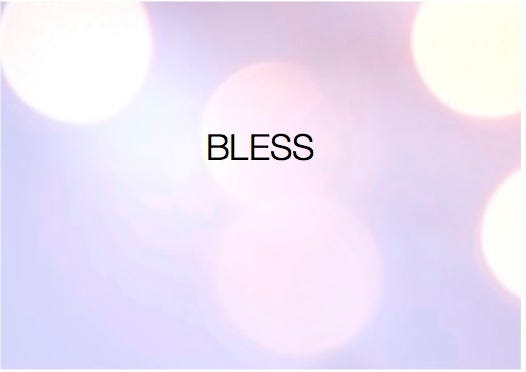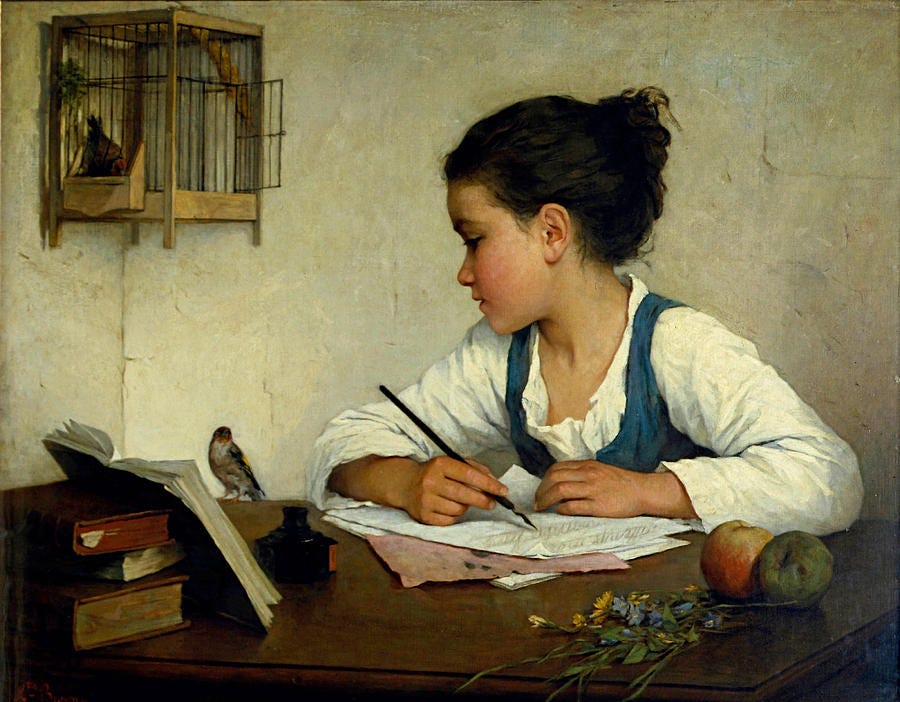Workshop: The One Who Blesses
Module One: An Intro (free) to the One Who Blesses workshop at Becoming Real
Ready to join the workshop?
Here’s a quick link to jump in!
In a world that feels increasingly unstable, reactive, and emergent, we are learning to feel beyond the rigid, forced posturing of one side against another. When we do, we discover it’s all bluster and illusion. What is stable, grounding, and quietly true remains.
Let’s begin by inviting everyone into blessing—not just paid subscribers. All of us. Wherever you are right now, begin there.
Stand where you are—or sit, or lie down, or rest your hands gently at the lower belly, just below your navel. Take a breath and feel it move into your body. Exhale and inhale. Feel your belly rise and fall beneath your hands.
As your body settles, take a moment to feel the landscape around you.
It may not be literal land. It may be the inner terrain of your life, your body, your emotions, your home. The relationships that shape you. The headlines that press on you.
Now imagine that you are standing at the center of all of this. And from where you stand, see the land stretching out in all directions. And above it all, imagine the presence of a great compassionate being, watching over the world— Not judging. Not fixing. Just blessing.
A being of great power - and such compassion that it can include everything, the good, the bad, the broken, in blessing.
Feel this being there. Feel its radiant light pouring over you.
Sense into its radiant heart.
Take a last cleansing breath and, as you exhale, imaging you are expelling all that is not light, all that is not blessing into the field of love that this radiant being holds.
There is a figure from the Buddhist canon called Avalokiteshvara, the bodhisattva of compassion. She is the one with the thousand arms. The one who sees all suffering, including all of the ways that we cause suffering—and still remains, still chooses to respond.
She is sometimes called The Lord Looking Down in Pity, but I think this is a mistranslation. A bodhisattva is not a Lord. It is an enlightened human soul who has chosen to reincarnate until all souls are free of suffering.
That doesn’t sound like pity to me. It sounds like compassionate companionship.
Rather than a "Lord," this is the image of the helper-healer. Mother Teresa, ministering to the exile, the untouchable, the leper. The deeper meaning of this name might be: the one who includes everyone in love. The compassionate companion who walks us through the world—no matter who we are or what we have done.
The one who blesses, who includes, rather than condemns.
We all know of people who walk the earth as embodiments of this vow. Not gods. Not gurus. Just humans—awake to the truth that everything they see is a mirror.
We know their names: Thich Nhat Hanh, Fred Rogers, Desmond Tutu, Dr. Hew Len.
They walk the same streets we do. They feel the same ache. And still, they choose to bless.
Thich Nhat Hanh, the gentle monk of Vietnam, who taught us to see the enemy as ourself. He taught us to hold even hatred with the soft arms of compassion. To breathe, to walk, to be still—until what once seemed separate becomes part of our own body.
Fred Rogers, in his soft voice and quiet cardigan, who looked through the television screen and saw every child watching him as worthy. As enough. As good.
Desmond Tutu, standing in the ruins of apartheid, who chose not revenge, but reconciliation. He blessed what had been broken—not by denying it, but by offering it a place in the circle again.
And someone you may not have heard of,
Dr. Hew Len, a clinical psychologist and devoted student of Morrnah Nalamaku Simeona, who became a leading teacher of Self I-Dentity through Ho’oponopono® (SITH®)—a modern system of self-awareness rooted in ancient Hawaiian principles.
SITH reminds us that when something appears in our field—anything—we are being asked to love it. To say: I’m sorry. Please forgive me. Thank you. I love you. Not to fix it. Not to fight it. But to clean the lens of our own perception until only blessing remains.
When something appears in our field - anything - we are being asked to love it.
The principle of Ho’oponopono is the same as the vow that governs the bodhisattva:
May all beings be happy. May all beings be free. May all beings be free of suffering.
The Sermon on the Mount carries the same vibration.
Jesus blesses the poor in spirit, the grieving, the meek, the hungry—those the world often overlooks. He urges us to love our enemies, to release judgment, to let our yes be yes and our no be no.
He does not teach us to fix others, but to see with clarity, to bless from the inside out. His teaching was not a command to dominate or convert—it was an invitation to purity of heart.
To become so empty of condemnation that we reflect the kingdom of heaven itself. This is the same field of blessing. The same vow: May all beings be free. May all be included in the good.
These are the ones who show us what blessing looks like in human hands.
But blessing is not only reserved for saints. It is a way of seeing, a way of being—available to all of us. Right here. Right now. I can bless - and so can you.
The principle at the heart of this entire workshop is:
That which I look upon is already part of the good.
If it appears to me as bad— If it stirs resistance or fear or judgment in me— Rather than condemn it, I offer it love.
I say: I’m sorry. Please forgive me. Thank you. I love you.
And in saying these words—not as magic, but as sincere invitation— I cleanse the lens of my own perception. I soften my gaze. And I return what I see to the circle of blessing.
This is not bypass. This is not denial. This is inclusion.
It is so simple, and completely radical:
Nothing and no one is left out.
All that we look upon is good,
included in the blessing of love.
And, this is a point worth amplifying:
True blessing is not a prayer to change the person before us. It’s not saying, "Bless your heart," while inwardly thinking, "...you ignorant wretch."
Blessing is (actually) an act of self-transformation, which clears (and recalibrates) the mind and heart of the one who blesses; and that changes the field around the one who blesses, recharging it with the pulsation and frequency of love - which is the natural way of the human. By this transformation, condemnation becomes inclusion and the conditional, shaming "love" of the poseur shifts to the unconditional stream of grace.
The healing occurs in the one who blesses.
This can be extremely disorienting.
We thought we were right - we thought we were charitable and suddenly we see how judgemental we’ve been. (We will talk about this in coming weeks.)
Witness the blessing offered in Mary Oliver’s luminous poem Wild Geese:
You do not have to be good.
You do not have to walk on your knees
for a hundred miles through the desert repenting.
You only have to let the soft animal of your body
love what it loves.
Tell me about despair, yours, and I will tell you mine.
Meanwhile the world goes on.
Meanwhile the sun and the clear pebbles of the rain
are moving across the landscapes,
over the prairies and the deep trees,
the mountains and the rivers.
Meanwhile the wild geese, high in the clean blue air,
are heading home again.
Whoever you are, no matter how lonely,
the world offers itself to your imagination,
calls to you like the wild geese, harsh and exciting—
over and over announcing your place
in the family of things.
As the poet blesses all that she looks upon, so you are allowed (and encouraged) to bless the world that you see.
And here is the First Key:
What is real can hold us.
In a world that feels increasingly unstable, reactive, and emergent, we are learning to feel beyond the rigid, forced posturing of one side against another. When we do, we discover it’s all bluster and illusion. What is stable, grounding, and quietly true remains.
The One Who Blesses doesn’t pretend the world is not in turmoil. The One Who Blesses doesn’t sugar-coat reality. They do something far more courageous:
They remain present. They stay in relationship. They keep listening.
This is the foundation of blessing.
The land that you bless has its own sovereignty.
And yet—your gaze matters. Your noticing matters.
Your loving presence changes the field.
This is not metaphor. This is reality.
(And we will talk about this in the weeks ahead.)
We’ll deepen our understanding of blessing by exploring questions like these:
– How to remain steady in an unsteady world
– How to perceive the stability of the grace field that holds us
– How to work with polarity and paradox—not to resolve it, but to hold it
– How to bless what we don’t yet understand
– How to recognize the voice of the Real—within and around us
We’ll do this through reflection, story, image, and invocation.
We’ll do it slowly - and steadily. One post a week, with a recording - my voice in your ear, reading the week's module, and embroidering as I’m inspired.
• Guided meditation
• Stories and teaching drawn from personal, collective, or archetypal experience
• Prompts for your journal and practices to engage blessing as a living relationship
If you’d like to join the workshop, become a paid subscriber.
Want to join but the fee of $8 (a month) is too much right now?
Send me a private note at amy@amyoscar.com and I’ll comp you in.
The work is for all who feel called to the work.
No exclusions.
Image Credit: A Girl Writing. The Pet Goldfinch by Henriette Brown. 1870.
This weekend:
A prompt for your journal
Think of something—or someone—you’ve withheld your blessing from.
It could be a situation, a person, a part of yourself.
Come to the journal page and ever so gently, ask yourself:
What story am I telling myself about this?
What if it’s not true - or perhaps, more complex than I perceived at the time?
What might happen if I moved this from condemnation to blessing?
Hold it in your mind and speak the words:
I love you. I’m sorry. Please forgive me. Thank you.
Write what you feel. Write what happens next.
This week (and beyond):
A prompt for living and noticing
Notice what you are blessing already, without realizing.
Notice what you withhold your blessing from.
Just notice, without judging or condemning yourself.
You are worthy of your own blessing, too.
Let blessing ripple through the field, touching you
and all that you see.
Consider this simple (powerful) choice:
I am the One Who Blesses.
I am the one who stands in the wild, sacred, emergent now—
Tending the new, even while the old is still dissolving.
(We’ll talk more about this next week, too.)
I bless you. I welcome you.
I hope that you’ll join me on the transformational
(and oh so beautiful) journey.
Amy
xxoo
Paid subscribers: Your audio will arrive by separate email.






